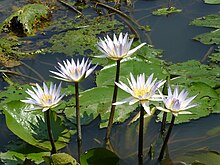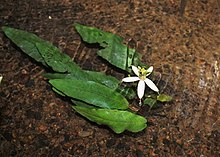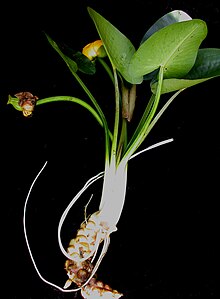
Back نيلوفرية Arabic نيلوفريه ARZ Nymphaeaceae AST Suzanbağıkimilər Azerbaijani Гарлачыкавыя BE-X-OLD Водни лилии Bulgarian শাপলা Bengali/Bangla ཆུ་པད་མ། Tibetan Nymphaeaceae BS Nimfeàcies Catalan
This article may be too technical for most readers to understand. (May 2021) |
| Nymphaeaceae Temporal range: Early Cretaceous - Recent
| |
|---|---|

| |
| Nymphaea nouchali | |
| Scientific classification | |
| Kingdom: | Plantae |
| Clade: | Tracheophytes |
| Clade: | Angiosperms |
| Order: | Nymphaeales |
| Family: | Nymphaeaceae Salisb.[1] |
| Genera | |
|
Extant genera[2] Fossil genera | |
| Synonyms[3] | |
| |




Nymphaeaceae (/ˌnɪmfiˈeɪsi.iː, -ˌaɪ/) is a family of flowering plants, commonly called water lilies. They live as rhizomatous aquatic herbs in temperate and tropical climates around the world. The family contains five genera[4] with about 70 known species.[5] Water lilies are rooted in soil in bodies of water, with leaves and flowers floating on or rising from the surface. Leaves are round, with a radial notch in Nymphaea and Nuphar, but fully circular in Victoria and Euryale.
Water lilies are a well-studied family of plants because their large flowers with multiple unspecialized parts were initially considered to represent the floral pattern of the earliest flowering plants. Later genetic studies confirmed their evolutionary position as basal angiosperms. Analyses of floral morphology and molecular characteristics and comparisons with a sister taxon, the family Cabombaceae, indicate, however, that the flowers of extant water lilies with the most floral parts are more derived than the genera with fewer floral parts.[clarification needed] Genera with more floral parts, Nuphar, Nymphaea, Victoria, have a beetle pollination syndrome, while genera with fewer parts are pollinated by flies or bees, or are self- or wind-pollinated.[6] Thus, the large number of relatively unspecialized floral organs in the Nymphaeaceae is not an ancestral condition for the clade.
- ^ Cite error: The named reference
apgiiiwas invoked but never defined (see the help page). - ^ "Nymphaeaceae Salisb". Plants of the World Online. Royal Botanic Gardens, Kew. Retrieved 22 July 2023.
- ^ Nymphaeaceae. (n.d.). GBIF | Global Biodiversity Information Facility. Retrieved August 4, 2023, from https://www.gbif.org/species/103019924
- ^ "Nymphaeaceae Salisb. Ann. Bot. (König & Sims) 2: 70. 1805. (Jun 1805)". World Flora Online. The World Flora Online Consortium. 2022. Retrieved 13 July 2022.
- ^ Christenhusz, M. J. M. & Byng, J. W. (2016). "The number of known plants species in the world and its annual increase". Phytotaxa. 261 (3): 201–217. doi:10.11646/phytotaxa.261.3.1.
- ^ Phylogeny, Classification and Floral Evolution of Water Lilies (Nymphaeaceae; Nymphaeales): A Synthesis of Non-molecular, rbcL, matK, and 18S rDNA Data, Donald H. Les, Edward L. Schneider, Donald J. Padgett, Pamela S. Soltis, Douglas E. Soltis and Michael Zanis, Systematic Botany, Vol. 24, No. 1, 1999, pp. 28-46
© MMXXIII Rich X Search. We shall prevail. All rights reserved. Rich X Search